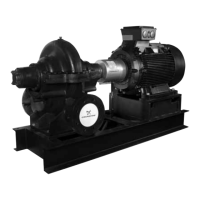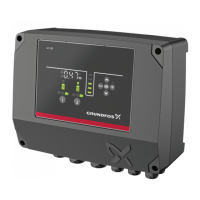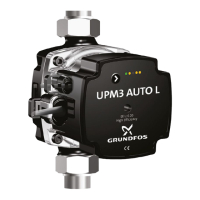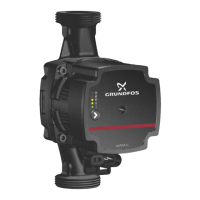English (GB)
42
11. Fault finding the product
DANGER
Electric shock
Death or serious personal injury
- Before you remove the terminal box cover and
before you remove or dismantle the pump, make
sure that the power supply has been switched off
and that it cannot be accidentally switched on.
Faults Causes
A: The pump delivers no liquid.
B: The pump does not deliver enough liquid.
C: The pump does not create enough pressure.
D: The pump loses liquid after running for a short time.
E: The pump consumes too much power.
F: The motor is overloaded.
G: Vibrations.
H: Cavitation noise.
I: The pump bearings are overheated.
J: The pump operates for a short time and then stops. K: Reference numbers to remedies.
AB C D E F G H I J K
●●
The pump is not primed, lack of priming liquid, incomplete
priming.
1
● Loss of priming liquid. 2
●● ● ● The suction lift or static lift is too high. 3
●● The outlet pressure is too high (measured at the outlet port). 4
●● ● The speed is too low. 5
●● Wrong direction of rotation. 6
●● The impeller is completely clogged. 7
● The inlet pipe is partially blocked. 8
●●● ● ●Air leak in the inlet pipe or flange. 9
●● ●Air leak in the stuffing box. The flushing pipe may be blocked. 10
●●● ● Cavitation; insufficient NPSH (depending on installation). 11
●● ● The impeller or wear rings are worn. 12
●● Defective packing rings. 13
●
The non-return valve is too small or partially obstructed. The
cross section of the non-return valve port must be at least as
large as the cross section of the inlet pipe.
14
●● ● The inlet pipe is not immersed deeply enough. 15
●
The impeller diameter is too small. This is the most probable
cause, if none of the above causes apply.
16
● Obstruction in the housing. 17
●●● ● Air or gases in the liquid. 18
●●
The actual duty point of the pump lies to the right of the specified
duty point on the pump curve. The result is lower head, higher
flow and higher power consumption.
19
●●
The viscosity or specific gravity of the pumped liquid is higher
than that of water.
20
●●● ● The shaft is bent due to damage. 21
●●● ● Mechanical failure of the bearing and/or impeller. 22
●●●Misalignment. 23
●● Electrical defects. 24
●● ● The speed is too high. 25
● The foundation is not rigid enough. 26
● The lubricating oil or grease is dirty or contaminated. 27

